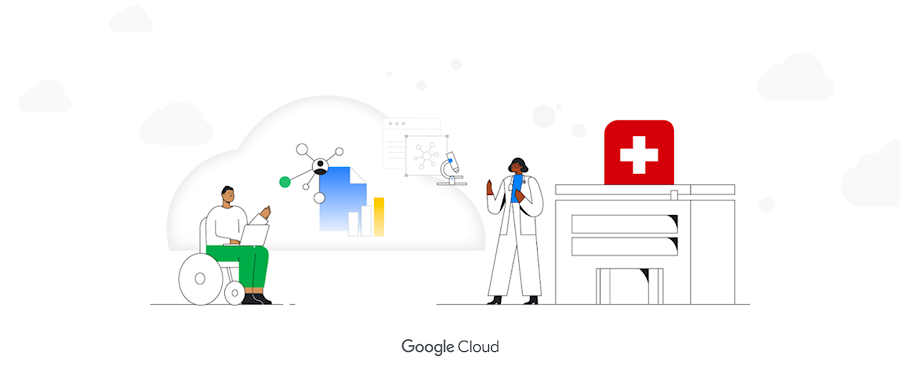Predict hospital readmission rates with Google Cloud Platform
Rachel Kamienski
Looker Enterprise Customer Engineer
Alick Zhang
Looker Technical Solutions Consultant
Try Google Cloud
Start building on Google Cloud with $300 in free credits and 20+ always free products.
Free trialToday’s challenge with healthcare data:
The amount of data collected today is at an all time high and the demand to leverage and understand that data is rapidly growing. Organizations across every industry want convenient, fast, and easy access to data and insights, while allowing users to take action on it in real-time. Healthcare is no exception.
In this recent GCP blog post, the importance of Electronic Health Records (EHR) systems and healthcare interoperability is explained. EHR systems by default do not speak to one another, and this makes it difficult to track patients within a health system across different hospitals or clinics. EHR data is highly complex, containing numerous diagnosis codes, procedure codes, visits, provider data, prescriptions, etc. Moreover, it becomes challenging to track a patient’s clinical history if a hospital upgrades their EHR system or when a patient switches hospitals (even within the same system).
The solution? A common data schema that can act as a mechanism for normalizing this messy real-world data across different EHR systems. This is known as the FHIR (Fast Healthcare Interoperability Resources) schema.
Google Cloud has seen a number of organizations implement solutions utilizing the Healthcare Data Engine (HDE) to produce FHIR records from streaming clinical data and then analyzing that data via BigQuery and Looker in order to uncover insights and improve clinical outcomes.
This shift toward the Cloud and business intelligence (BI) Modernization provides organizations with a single-platform that has the flexibility to scale, the ability to create a unified, trusted view of business metrics and logic, and an extensible activation layer to drive decisions in real-time.
Background and business opportunity:
According to the Mayo Clinic, the number of patients who experience unplanned readmissions to a hospital is one way of tracking and evaluating the quality and performance of provider care. By definition, a 7-day readmission rate is the percentage of admitted patients who return to the hospital for an unplanned visit within 7 days of discharge. This indicator can reflect the breadth and depth of care that a patient has received. Not only is a high readmission rate a reflection of low quality of care, but also unnecessary readmission rates are expensive. This is especially relevant to hospitals and providers in a value-based reimbursement environment.
When it comes to accurately analyzing and understanding hospital readmission rates, amongst many other quality and performance metrics in a healthcare setting, common obstacles include: latency, scalability, speed, governance, security, and overall accessibility in sharing results.
Recently, we examined a real-world use case for predicting 7-day hospital readmission rates utilizing FHIR data stored in BigQuery, along with BigQuery ML, Looker and Cloud Functions.
BigQuery is Google Cloud’s fully managed, serverless SQL data warehouse and data lake. It’s highly performant for fast querying, and it is secure and fully encrypted in the Cloud and in transit to other locations. It also has a feature called BigQuery ML, which allows users to execute machine learning (ML) models in BigQuery using standard SQL. BigQuery ML offers models, like: linear regression, binary logistic regression, multiclass logistic regression, K-means clustering, matrix factorization, time series, boosted tree, Deep Neural Network (DNN), and more. You can also use its AutoML feature, which searches through a variety of model architectures based on the input data and chooses the best model for you. BigQuery ML increases development speed by eliminating the need to move data and allows data science teams to focus their time and effort on more robust and complex modeling.
Looker is Google Cloud’s cloud-native BI and analytics platform that gives users access to data in real-time through its in-database architecture and semantic modeling layer. Looker connects directly to BigQuery (as well as most other SQL-compliant databases), meaning you do not have to move or make copies of the data, and you are not limited to cubes or extracts. This enables governance at scale where Looker acts as the single source of truth for users to go for information and take action on insights.
Cloud Functions offer a serverless execution environment for building and connecting cloud services. You can write simple, single-purpose functions that can be activated when triggered. Cloud Functions can act as the bridge for communication between insights in Looker and BigQuery.
Our goals with this use case solution were to (1) help hospital clinicians and administrators know where to most focus their attention when it comes to 7-day readmission rates, and (2) be able to initiate proactive interventions through alerting, self-service, and data-driven actions, and finally, (3) scale, govern, and secure the data on a modern, unified platform in the Cloud.
The solution and how it works:
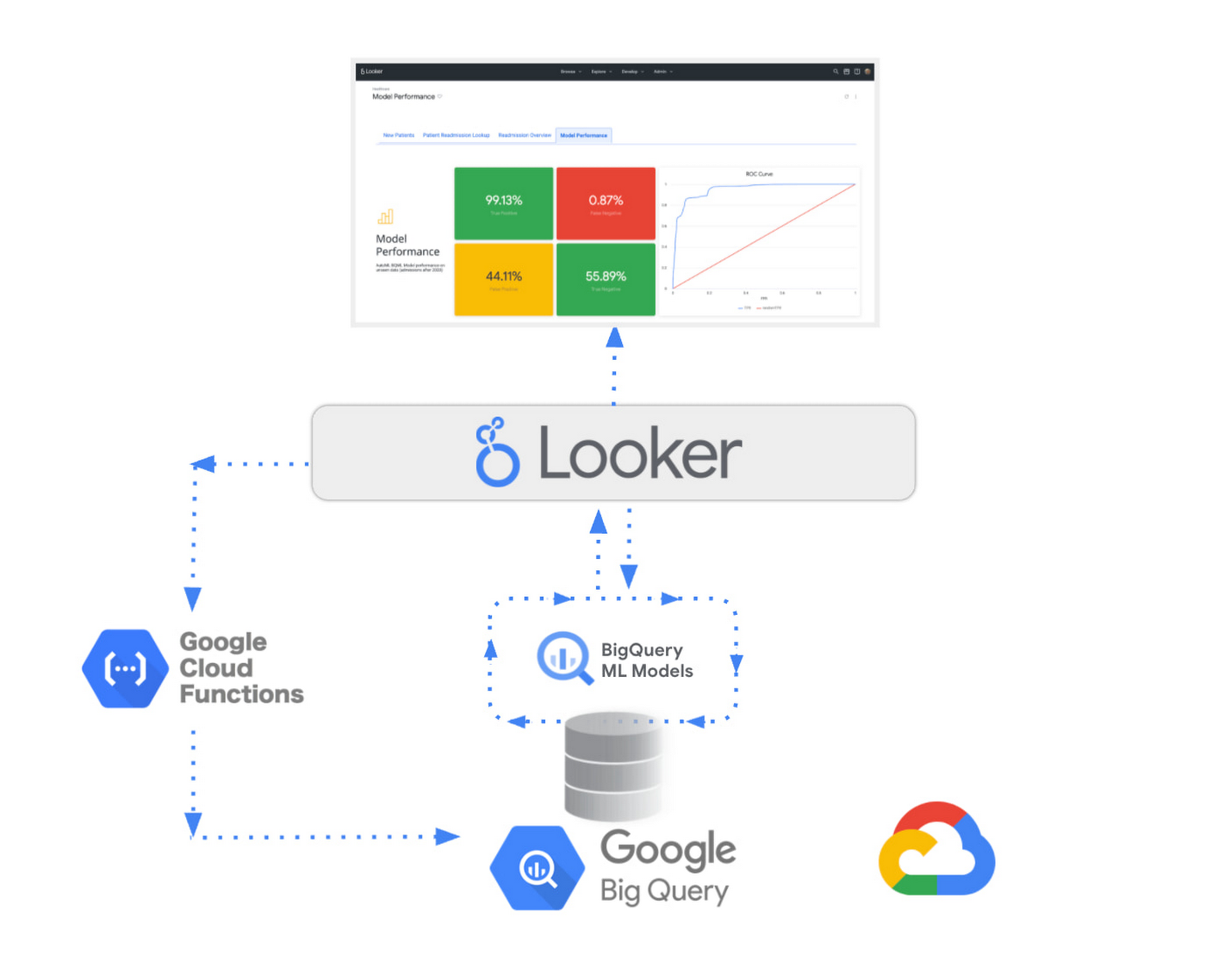

Once our data is in BigQuery and we’ve connected it to Looker, we can begin our analysis. Looker’s semantic modeling layer leverages LookML, which is an abstract of SQL that simplifies SQL by turning it into reusable components. We can use LookML to make transformations to build and define unified metrics. Then we can write a BigQuery ML model directly in Looker’s semantic modeling layer by implementing the BigQuery ML Looker Block for Classification and Regression with AutoML Tables.
The Block goes through the components of how to train, evaluate, and predict for our target variable. In our use case, the target variable is the propensity score for a 7-day readmission. As mentioned, BigQuery ML gives us the ability to quickly do this using standard SQL. We can assess our model performance using the out-of-the-box evaluation functions provided by BigQuery ML and easily tune hyperparameters as needed using model options in the CREATE MODEL syntax.
The benefits of building the model in Looker are:
In contrast to traditional data science methods, we can keep our code in a single location for ease of use and access
We can choose the refresh frequency to continue to automatically re-run the model based on new incoming data
It is fast to implement the code, and it’s easy to visualize and explore the results in the Looker UI
We can create a dashboard within Looker that highlights the key performance indicators of the model. Using other data science methods, accuracy and precision results might be inaccessible or difficult to share. A Looker dashboard will provide transparency into how the model performed, and because Looker reads directly from BigQuery, as new data comes in, we are able to view changes in predictions in real-time, as well as view any variations in model performance KPIs.
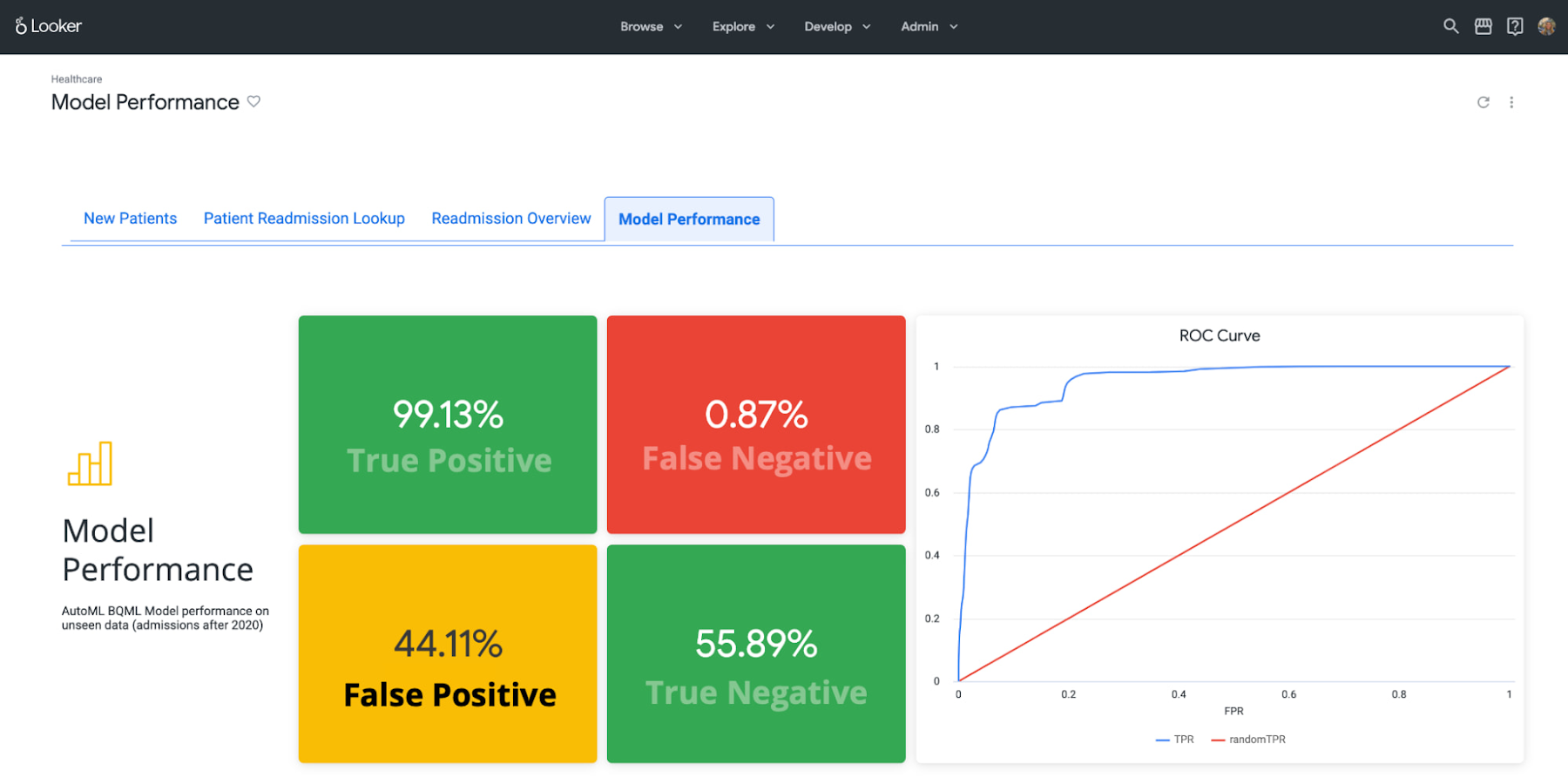

In addition to building out a dashboard for model performance, we can also analyze readmission rate across the hospital and at the patient level. We built examples to show how an overview dashboard allows hospital clinicians, care managers, and administrators to see how the hospital is performing overall, by facility, by specialty, or by condition, while the patient view shows an individual patient and their average readmission rate score.


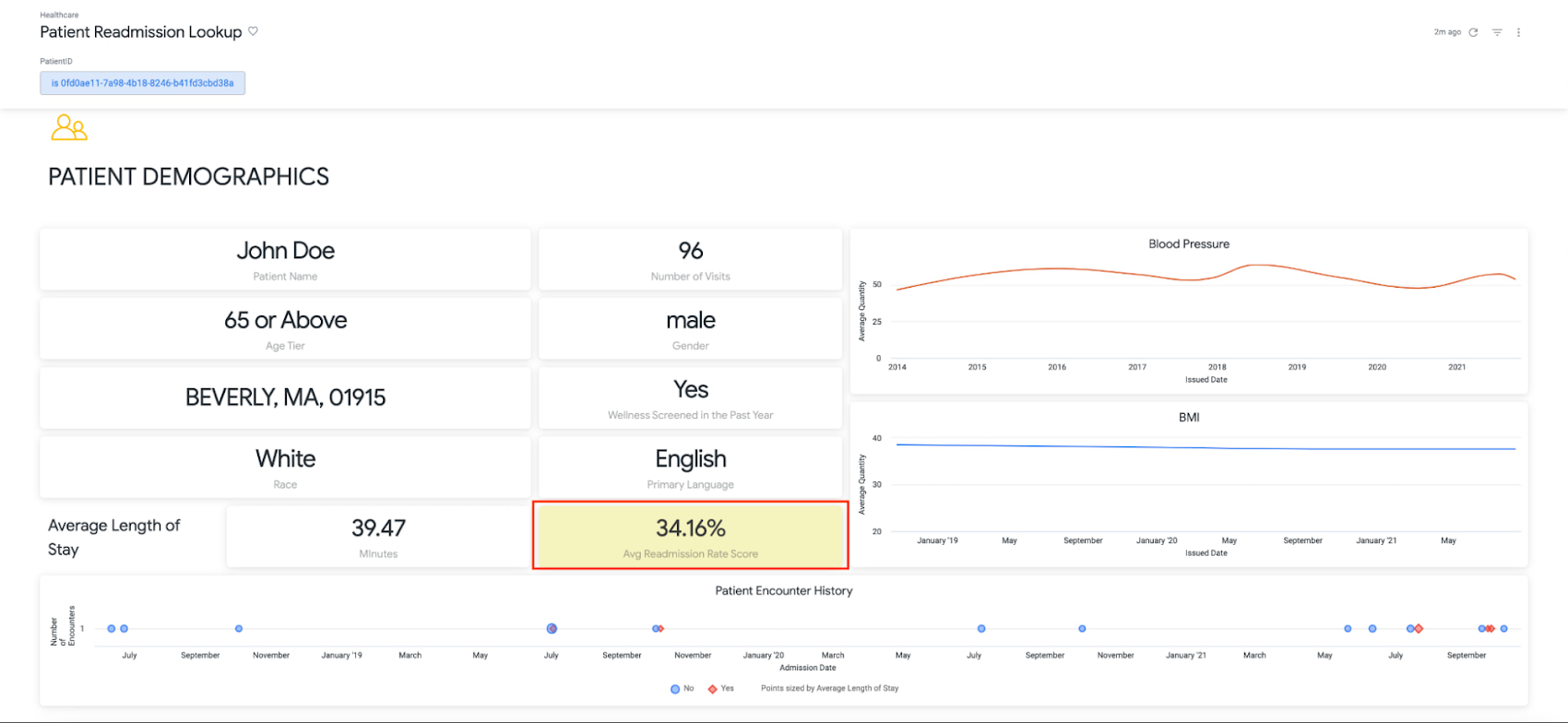

Patient Readmission Dashboard: Sample showing average readmission rate risk score of 34.16% for patient John Doe
*Disclaimer: Sample synthetic data was used in the exploration of this use case (meaning, no real PII or PHI data was used)
Within Looker, clinicians or care managers can then set up alerts to monitor their individual patients based on the predicted score. With Looker alerts, they can also set a threshold and be notified whenever that threshold is reached. This allows care managers to be more proactive rather than reactive when putting together discharge care plans for their patients.
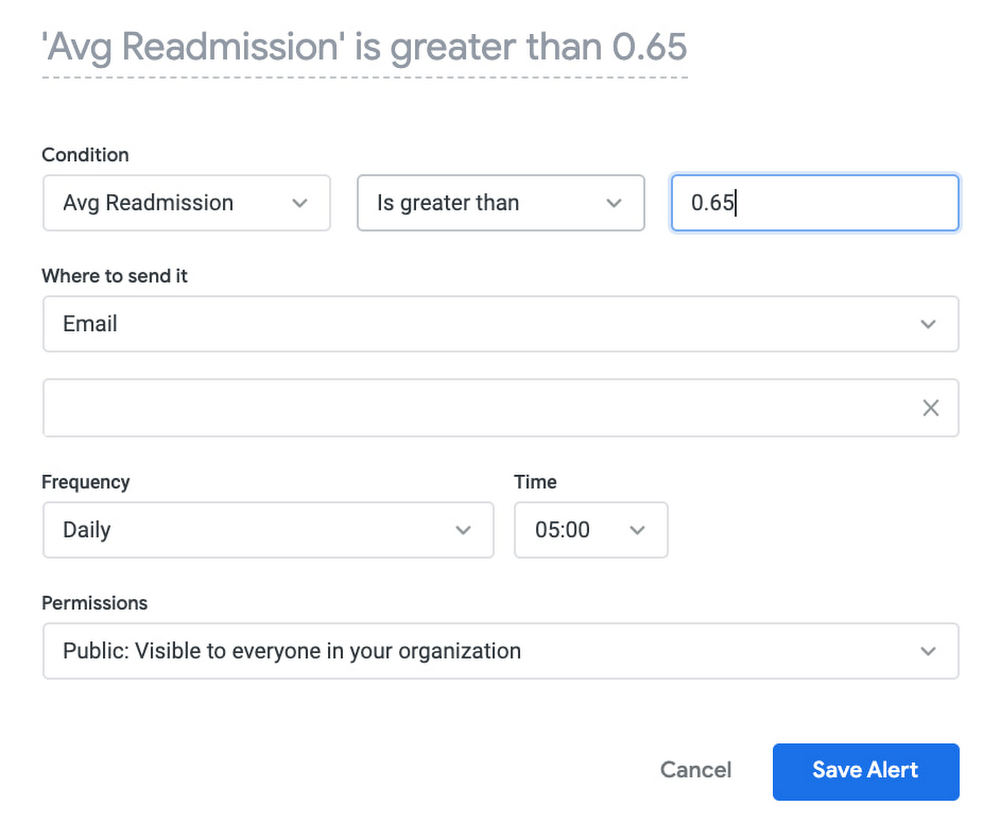

A care manager can also quickly send an email follow-up to a patient with a high-risk score directly from within the platform.
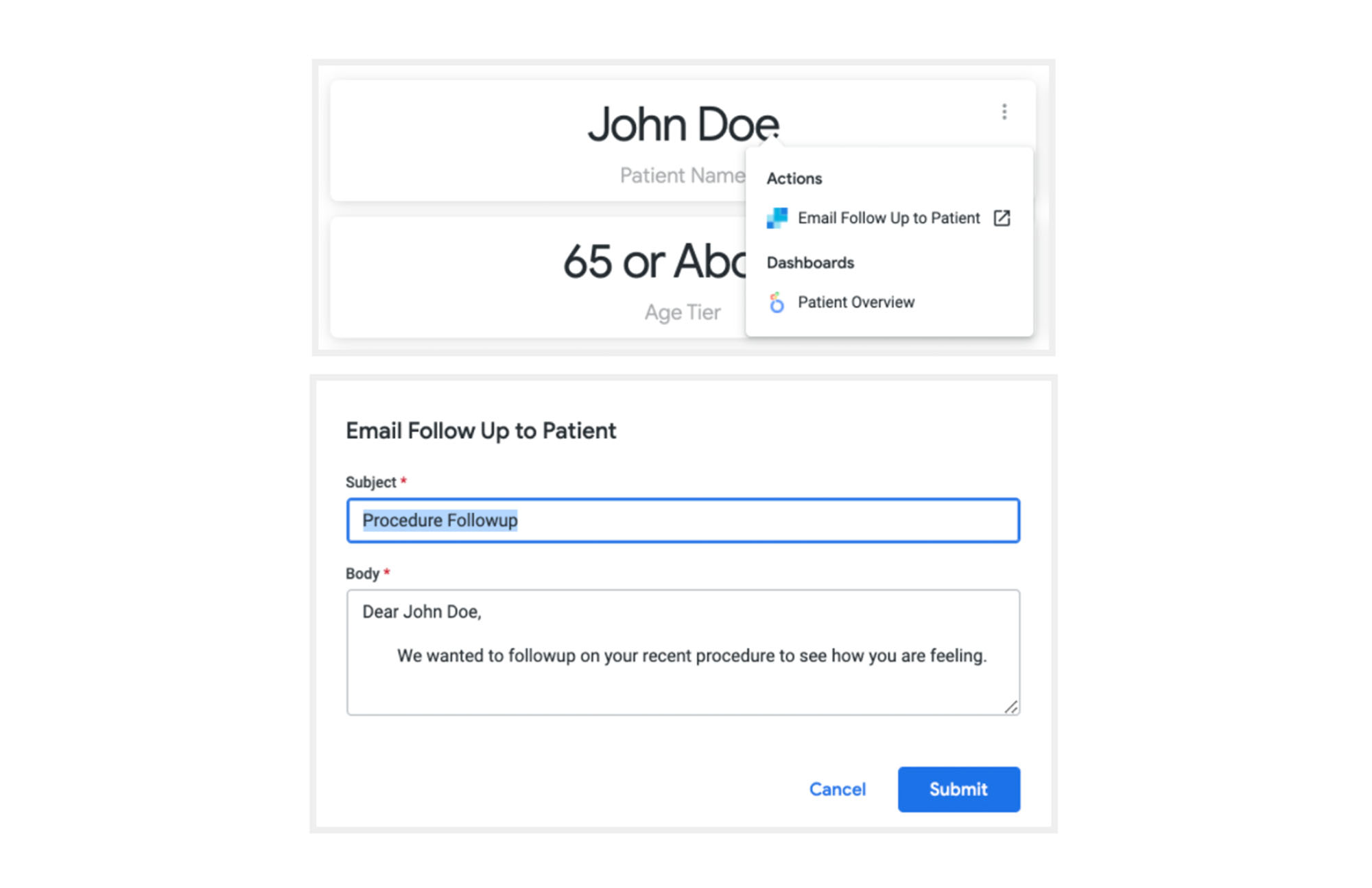

This is an example of a Looker Action. There are many possibilities, such as:
Send a text message with Twilio
Send data to Google Sheets
Send data to a repository, such as Google Cloud Storage
Use a form to write-back to BigQuery
When it comes to write-backs, Cloud Functions make the process simple. In our use case, in order to collect patient feedback and satisfaction data at discharge, we built a form in LookML. A Looker Action then triggers a write-back any time the form is submitted. The write-back is executed by a Cloud Function behind the scenes. The form makes it seamless and easy for hospitals to quickly collect survey data and store it in a structured format for analysis. Once in BigQuery, the data can then ultimately be passed back into our BigQuery ML model as additional features for retraining and predicting readmission rate risk scores.
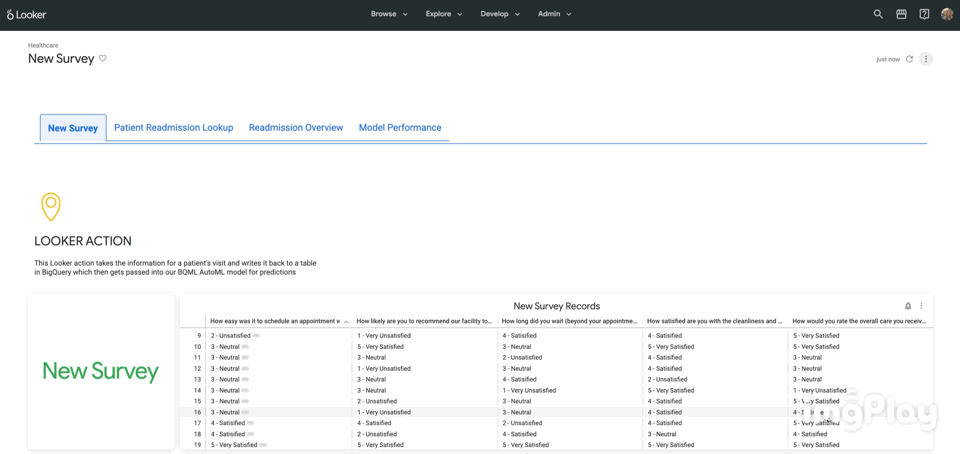

Check out the sample Cloud Function code on GitHub here.
The value and potential future work:
Google Cloud provides a seamless experience with the data. This solution addresses challenges of latency, scalability, speed, governance, security, and overall accessibility in sharing results. Looker’s in-database architecture and semantic modeling layer inherit the power, speed, and security of BigQuery and BigQuery ML, and when implemented with Cloud Functions, Looker can enhance both data and operational workflows. These workflows impact how clinicians, care managers, hospital administrators, and data scientists manage their day-to-day, which in turn help keep healthcare costs down and improve the quality of patient care.
Future work in building out this solution may include leveraging the GCP Healthcare NLP API, which converts unstructured data, such as clinical notes, into a structured format for exploration and additional downstream AI/ML.
Keep an eye out for more to come on Looker Healthcare & Life Sciences Solutions!
